
|
You entered: ice
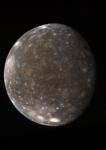 Oceans Under Jupiters Callisto
Oceans Under Jupiters Callisto
31.07.2001
Why does Jupiter's moon Callisto alter the magnetic field of Jupiter in its vicinity? Callisto itself does not have a strong magnetic field. One possible answer is that Callisto harbors sub-surface oceans of electrically conducting salt-water. This hypothesis was bolstered recently by a new analysis of how Callisto creates and dissipates heat.
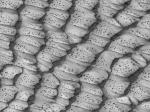 The Dotted Dunes of Mars
The Dotted Dunes of Mars
31.08.2004
What causes the black dots on dunes on Mars? As spring dawns on the Northern Hemisphere of Mars, dunes of sand near the poles being to defrost. Thinner regions of ice typically thaw first revealing sand whose darkness soaks in sunlight and accelerates the thaw.
 Searching for Meteorites in Antarctica
Searching for Meteorites in Antarctica
26.12.2002
Where is the best place on Earth to find meteorites? Although meteors fall all over the world, they usually just sink to the bottom of an ocean, are buried by shifting terrain, or are easily confused with terrestrial rocks.
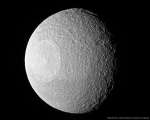 Odysseus Crater on Tethys
Odysseus Crater on Tethys
5.02.2017
Some moons wouldn't survive the collision. Tethys, one of Saturn's larger moons at about 1000 kilometers in diameter, survived the collision, but today exhibits the resulting expansive impact crater Odysseus. Sometimes called...
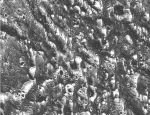 Ancient Cratered Plains on Ganymede
Ancient Cratered Plains on Ganymede
12.07.1996
The largest moon in the Solar System shows regions that are ancient and battered. The high density of craters demonstrate that patches of Ganymede are indeed billions of years old. This photo is one of a series released by NASA two days ago from the Galileo spacecraft orbiting Jupiter.
 Triple Sunrise
Triple Sunrise
23.09.2006
Today, the Sun rises due east at the Equinox, a geocentric astronomical event that occurs twice a year. To celebrate, consider this view of the rising Sun and a lovely set of ice halos recorded on a cold winter morning near Green Bay, Wisconsin, USA, planet Earth.
 Halo and Hexagons
Halo and Hexagons
9.11.2006
As a bright November Moon lit up the night sky last week, Gil Esquerdo spotted this lovely Moon halo overhead at the Whipple Observatory on Mt. Hopkins, Arizona. In the foreground, the structure...
 Northern Pluto
Northern Pluto
27.02.2016
Gaze across the frozen canyons of northern Pluto in this contrast enhanced color scene, imaged last July by the New Horizons spacecraft. Currently known as Lowell Regio, the region has been informally named for Percival Lowell, founder of the Lowell Observatory.
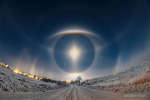 APOD: 2024 December 25 Б Diamond Dust Sky Eye
APOD: 2024 December 25 Б Diamond Dust Sky Eye
25.12.2024
Why is there a huge eye in the sky? Diamond dust. That is an informal term for small ice crystals that form in the air and flitter to the ground. Because these crystals...
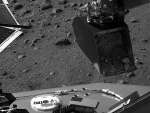 Mars Soil Sample Ready to Analyze
Mars Soil Sample Ready to Analyze
8.06.2008
What surprises are hidden in the soils of Mars? To help find out, the Phoenix Lander Phoenix Lander which arrived on Mars two weeks ago has attempted to place a scoop of soil in Phoenix's Thermal and Evolved-Gas Analyzer (TEGA). Pictured above, the dirt-filled scoop approaches one of TEGA's eight ovens.
|
January February March April May June July |
|||||||||||||||||||||||||||||||||||||||||||||||||